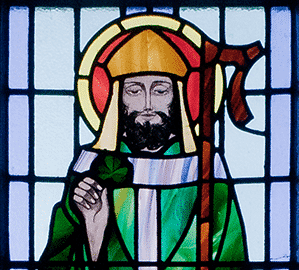… He wasn’t a canonized saint, nor did he drive the snakes from Ireland.
By M. Christine Watson
Global Marketing Director, Daxtra Technologies
 Founded and headquartered in Scotland, Daxtra Technologies holds near and dear to our hearts the traditions and lore of our region. As a global force, we also recognize traditions celebrated world-wide. But many times lore rules over fact, so let’s just set the record straight…
Founded and headquartered in Scotland, Daxtra Technologies holds near and dear to our hearts the traditions and lore of our region. As a global force, we also recognize traditions celebrated world-wide. But many times lore rules over fact, so let’s just set the record straight…
Each March 17th with the blare of bagpipes and green beer, we in America celebrate St. Paddy’s Day. Yes, and those in Ireland want Americans to know, it’s not St. Patty’s Day, but St. Paddy’s, or St. Patrick’s Day. But, there are a few things you should know about St. Patrick on this upcoming day of celebration, as our modern day of celebration has drifted away a bit, from it’s origins.
St. Patrick wasn’t Irish. It’s thought that Patrick was born to an aristocratic family in Britain around A.D. 390 — a family who lived in lived in a townhouse and owned a country villa complete with slaves. Although born into Christianity, he had no real interest in it. His comfortable life was disrupted when at 16 he was kidnapped and sold into slavery where he was sent to the mountainous region of Ireland to tend sheep. There he had a conversion to Christianity which helped him get through this hardship. Lore has it that a voice spoke to him and told him to escape, which he did by gaining passage on a pirate ship back to his family in Britain.
 Back in Britain, Patrick, or rather the Irish spelling Pádraig — hence Paddy, not Patty — studied and became an ordained priest. Years later, he had another vision or voice, which told him to return to Ireland and work on converting the largely pagan Irish. According to National Geographic, he did this by incorporating Christianity into the pagan traditions and holidays.
Back in Britain, Patrick, or rather the Irish spelling Pádraig — hence Paddy, not Patty — studied and became an ordained priest. Years later, he had another vision or voice, which told him to return to Ireland and work on converting the largely pagan Irish. According to National Geographic, he did this by incorporating Christianity into the pagan traditions and holidays.
Patrick was fairly successful at his mission, which wasn’t an easy task. Nor was his life easy in Ireland. But none of his mission involved driving snakes from Ireland. True, Ireland doesn’t have snakes, but this is because of the icy waters surrounding the island preventing migration of reptiles like snakes. The lore fit nicely with this fact though, as it symbolically says he drove the old, evil, pagan ways out of Ireland and brought in a new age, serpents being the metaphor for druidic religions.

May you have the hindsight to know where you’ve been,
the foresight to know where you are going,
and the insight to know when you have gone too far.
— Old Irish Proverb —

An interesting fact is, St. Patrick was never formally canonized, either. He was most likely proclaimed a saint by popular acclaim with the approval of a bishop. “The official process for canonization did not come until about the 12th century.” He should be known and celebrated as being the first major figure to reject slavery and for that alone he deserves proper canonization.
An American-made Holiday

Because of his success as a missionary, he is celebrated. What for centuries was a feast day in the UK, March 17th, the purported day of his death, became much more of an American celebration than it had ever been in the UK.

Irish immigrants held the first St. Patrick’s Day Parade in NYC, in 1762 and Chicago has long held a parade with the tradition of dyeing the Chicago River a brilliant emerald green on the 17th. But it wasn’t until the 1970’s that the wild shamrock-wearing, Guinness-drinking, dying the river green, bawdy St. Patrick’s Day celebrations sprung forth in America, setting a trend for raucous celebrations world-wide.
As the patron saint of Ireland, Patrick is celebrated there as a national Holiday. World-wide we celebrate by wearing sprigs of shamrocks, the three-leaf variety, not four, representative of the holy trinity. We invoke leprechauns, wear green, drink beer, dance a gig.… Everyone is suddenly Irish, or the stereotypical version of an Irishman.

There are only two kinds of people in the world,
the Irish and those who wish they were.
— Old Irish Proverb —

This year, as you tip your pint ‘o’ Guinness with a twinkle in your eye, enjoy the lore, blarney though it be!
For more on St. Patrick’s Day around the world, click here.


